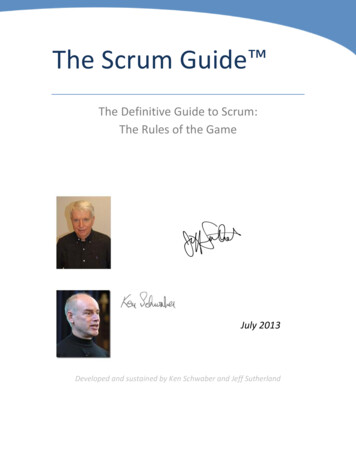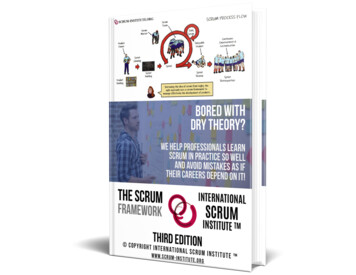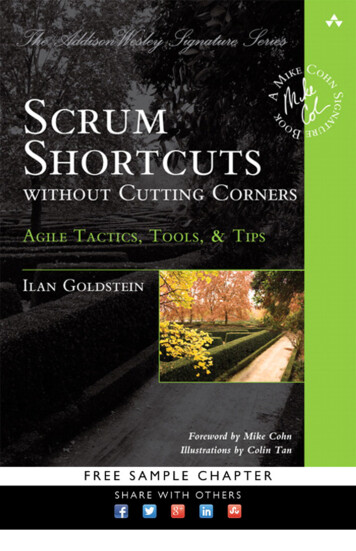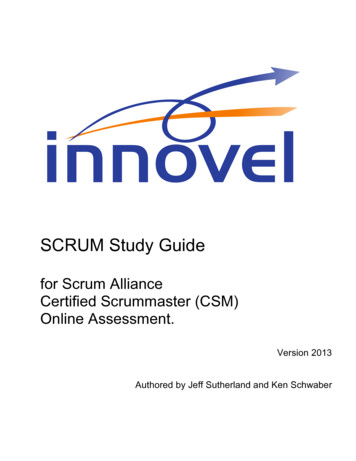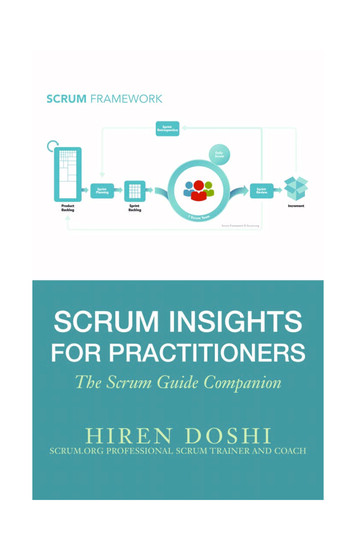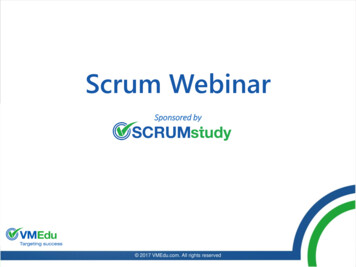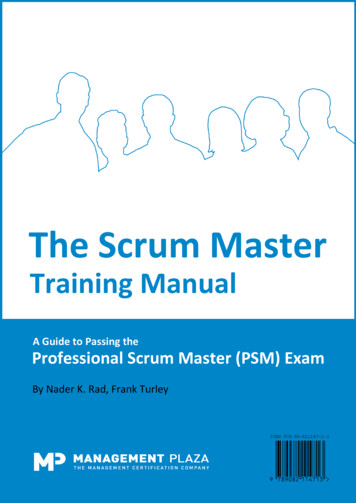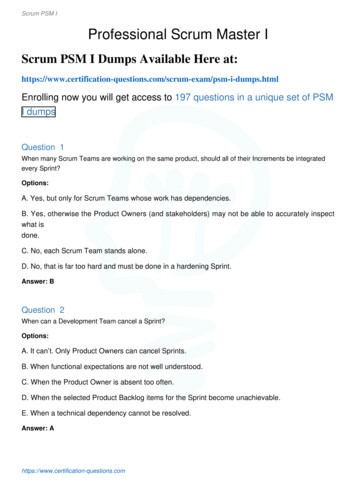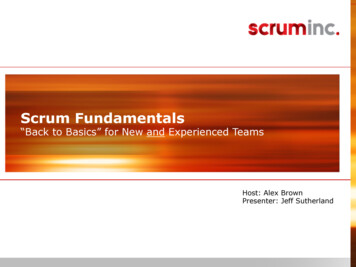
Transcription
Scrum Fundamentals“Back to Basics” for New and Experienced Teams 2011 Scrum Inc. 2013 Scrum Inc.Host: Alex BrownPresenter: Jeff Sutherland
: Who We AreScrum Inc. is the Agile leadership company of Dr. Jeff Sutherland,co-creator of Scrum. We are based in Cambridge, MA.We maintain the Scrum methodology by: Capturing and codifying evolving best practices, Conducting original research on organizational behavior Adapting the methodology to an ever-expanding set ofindustries, processes and business challengesWe run our services company using Scrum as the primary managementframework, making us a living laboratory on the cutting edge of .3 2013 Scrum Inc.We also help companies achieve the full benefits of Scrum through our full suiteof support services: Training (Scrum Master, Product Owner, Agile Leadership, webinars, etc.) Consulting (linking Scrum and business strategy, customizing Scrum) Coaching (hands-on support to Scrum teams) Publishing and new content development
Agenda Why use Scrum? The origins of Scrum The elements of Scrum What they are How Scrum works Why Scrum works What Scrum allows us to do2 2013 Scrum Inc. Introduce Scrum patterns
2013 Scrum Inc.
Scrum Supports Organizations in 3 WaysFasterScrum helps teams continuously improve,so that they can produce more in lesstimeBetterScrum puts the customer at the center ofdesign and development, resulting inmore commercially successful products 2013 Scrum Inc.Happier Scrum empowers working teams to makedecisions and harness their talents,leading to greater employee satisfaction
In 1993 Easel Corporation needed to build a new product insix months. They hired Jeff Sutherland to lead a smalldevelopment team trusting that he could do it Software development projects at that time, kept getting laterand later and more and more expensive! Convinced there had to be a better way than traditionalwaterfall development, Jeff and the team researched studiesand publications on how the best teams function. They readhundreds of papers. 2013 Scrum Inc.Origins: Facing a really hard problem
2013 Scrum Inc. 1993-2012 Jeff Sutherland
Ikujiro Nonaka: Grandfather of ScrumSutherland, Kenji, Nonaka - Tokyo, Jan 2011The Japanese view Scrum as: 1993-2012 Jeff Sutherland 2013 Scrum Inc. A way of doing A way of being A way of life
The Scrum FrameworkScrumSprintBacklog3 SocialObjectsScrum BoardPointsVelocityBurndown ChartMakeWorkVisibleSprint PlanningReady!Daily ScrumPO3 RolesScrumMasterSMTTTeamT5 CeremoniesBacklog GroomingProductOwnerSprint ReviewDone!Sprint RetrospectiveKaizen 2013 Scrum Inc.ProductBacklog
A Scrum Team has Three RolesPO2.SMTT3.Product Owner: Define and prioritize the features of the Product Backlog Decides on release date and content Responsible for the profitability of the product (ROI)ScrumMaster: Facilitates the Scrum process and Team self-organization Removes obstacles or impediments Shields the team from interferenceTeam: Cross-functional (incl. testing) Self-organizing/-managing group of individuals, autonomy regarding howto achieve its commitments Typically 3-9 peopleTScrumInc. 20122013ScrumInc.1.
Scrum Team Characteristics Autonomy Transcendence Mastery through Cross-fertilization Moving the Scrum downfield Built-in instabilitySelf-organizing project teamsOverlapping development phases“Multi-learning”Subtle controlOrganizational transfer of Considerelimina ide 2013 Scrum Inc. Scrum formation
The Product Backlog Represents the product vision and centerpiecefor discussion about project direction There is only one product backlogComposed of individual features in the finishedproduct The Product Backlog Evolves over time Everyone encouraged to add itemsFeedback and learning from each Sprintincorporated back into Product Backlog The Product Owner orders the Backlog Ordered to provide maximum return on investmentTeam provides input on implementation Most important items at the top, will be done next, defined in greaterdetail Items further down the backlog will be done later and don’t need asmuch detail 2013 Scrum Inc. Different Backlog Items are defined at different levels ofspecificity
Make Work VisibleMakingworkvisibleenablesen routputThe Scrum Board Points Velocity(points)400ReleaseBacklog(points) How many points team can produce in each SprintUsed to plan work for coming Sprint and futuredelivery datesBurndown Chart SprintConsistent measure of team outputUsed to measure concretely whether team isgetting faster over timeVelocity SprintCentral “information radiator” that shows currentstatus of all stories in the Sprint BacklogAnswers the question “given our current progress,are we on track to meet expected delivery dates?” 2013 Scrum Inc.
The Sprint and iterative developmentWhat is it? A cycle of work A team-determined length of time inwhich the team commits to producing ameaningful increment of work Time-boxed and usually lasts 1-4 weeks A fixed anchor A tool that allows a team to calculate velocity A period of time in which the team can derive lessons for thefuture A fixed planning horizonScrumInc. 20122013ScrumInc.Why do it?
Scrum has Five MeetingsSprint Planning Daily Scrum Refine upcoming backlog items to ensure they areREADY when neededSprint Review 15-minutes, 3 questionsTeam self-organizes to increase transparency andimprove performanceBacklog Grooming Get the top items in the Product Backlog READY topull into Sprint BacklogCommit to work to be completed over next SprintShare what is DONEGet feedback on what the team has doneDetermine Team velocitySprint Retrospective Reflect on how the team has worked togetherIdentify the top process improvement for next sprint 2013 Scrum Inc.
Sprint RetrospectiveSource: Henrik Kniberg 2013 Scrum Inc.The key to continuous improvement
ScrumInc. 20122013ScrumInc.How Scrum Works
1EmbracingChangeChange and uncertainty are not an inconvenience, but a source ofopportunity. Organizations that manage uncertainty better possessa strategic competitive advantage2SelfOrganizationEveryone, from the CEO to entry-level employees, is responsiblefor getting work done and empowered to decide how to do it. Anystructure more than the minimum needed to work is WASTE3BusinessValue FocusAll activities are viewed through the lens of what creates value forthe business. Every sprint, we prioritize the work that generatesthe most business value at that point in time4ContinuousImprovementEvery day and in everything we do, we think about how to workbetter and then follow-through to remove the top impediment. Ouriterative work approach allows us to improve faster5NoninterruptionWe work best when we focus on one thing until it is DONE, all theway thru to a saleable product. Multi-tasking imposes switchingcosts on us, and is less efficient6CustomerCentrismThe customer is the core motivation for our work. We are eager todiscover what they like, and our highest priority is to satisfy thecustomer early and often7RadicalTransparencyHaving everyone know where we stand in as close to real-time aspossible allows us to make better and more responsive decisionsScrumInc. 20122013ScrumInc.Why Scrum Works
Scrum is easy to understand. Patterns canhelp avoid problems in implementation.1. How do you get started? (Stable Teams)2. How do you successfully pull backlog into a sprint?(Yesterday’s Weather)3. How do you get stuff done? (First Things First)4. How do you deal with interruptions during the sprint? (Illigitimusnon Interruptus)5. How do get defect free at the end of the sprint? (Daily CleanCode)6. How do you ensure you continuously improve? (Scrumming theScrum)8. How do you get hyper-productive? (Teams that Finish EarlyAccelerate Faster)Moreatscrumplop.org 2013 Scrum Inc.7. How do you get teams to have fun? (Happiness metric)
Scrum helps us reach our greater Potential“ We hold these truths to be selfevident, that all men are createdequal, that they endowed by theircreator with certain inalienable rights,that among these are life, liberty,and the pursuit of happiness ” 2013 Scrum Inc.- United States Declarationof Independence
All People are Created EqualIn Scrum No One is The Boss Three roles do notrepresent a hierarchy Product Owner Scrum Master TeamHamel, Gary. First, Let’s Fire All the Managers. Harvard Business Review, Dec 2011 2013 Scrum Inc. Yet key roles are moreaccountable than intraditional projectmanagement
Right to LifeScrum Gives People a Life!No more overtimeGoal: twice as much production with half the workOpenview Venture PartnersJ. Sutherland and I. Altman, "Take No Prisoners: How a Venture Capital Group Does Scrum," in Agile 2009, Chicago, 2009. 2013 Scrum Inc.
Right to LibertyScrum Gives People Freedom! Based on complex adaptive systems Self-organization is fundamental Teams are autonomous They own the work They choose the work They decide how to do the work Managers do not “push” work 2013 Scrum Inc. Teams “pull” work
Right to the Pursuit of HappinessScrum Makes People Happy (ScrumBut not so much!)ChaosLateUpsetPressureUnhappyTraditional ProjectManagementadyeRtNooneNot rovement35%improvement 2013 Scrum Inc.EarlySupportiveFunEcstatic
Conclusions: Just Get Started! The most important thing about starting a Scrum project is justthat, starting. By eliminating detailed planning and embracing that you willlearn along the way, you can do five projects for the cost of one Just remember to keep continuing focus on the SprintRetrospective and process improvement everything else youcan self-discover. Continuous assessment of where you are iskey! 2013 Scrum Inc. No need for weeks or months of planning and writing specificationsand requirements, just enough decent backlog to start the firstsprint 80% of the current cost of an average project is detailed upfrontplanning wastes valuable resources
2013 Scrum Inc.Ques ons?
Stay ConnectedOur Website check in for announcements, new content and services, bookreleases, and more! www.scruminc.comScrumLab join the conversations on our forums with the scrum communityand your class. coming soon: articles, videos, papers on all things scrum scrumlab.scruminc.comBlog scrum.jeffsutherland.comWebinarsTwitter, Facebook, and G @jeffsutherland, scrum and scrum inc.27 20122013ScrumScrumInc.Inc. advance your learning with our interactive webinars. visit thescrumlab store to view upcoming topics.
Scrum Inc. is the Agile leadership company of Dr. Jeff Sutherland, co-creator of Scrum. We are based in Cambridge, MA. We maintain the Scrum methodology by: Capturing and codifying evolving best practices, Co
